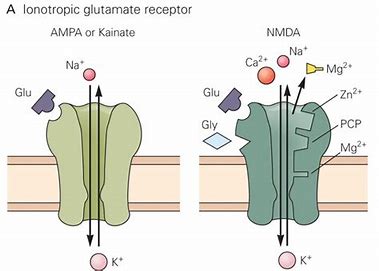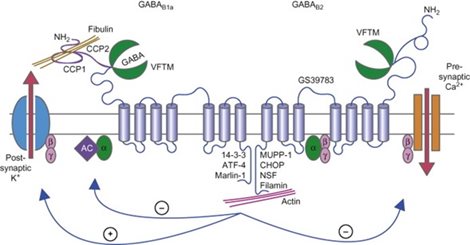Neurotransmitters
Neurons initiate communication by exchanging neurotransmitters through synaptic transmission that allows communication between neurons, sensory organs, motor organs, and other neuronal cell populations to the post synaptic terminal of the cell body, which in turn activates either inhibitory or excitatory effects.
Neurotransmitters are chemical messengers that transmit a message from a nerve cell across the synapse to a target cell. The target can be a nerve cell, a muscle cell, or a gland cell. They are released by the axon terminal of a neuron (the presynaptic neuron) and bind to and react with the receptors on the dendrites of another neuron. Neurotransmitters allow the impulse to cross a synapse (excitatory) or stop the impulse and prevent it from crossing a synapse (inhibitory). Neurotransmitters are themselves affected by agonists which amplify their effect and antagonists which reduce their effect.
There are two types of receptors:

Figure 1 (Kandel E.R 2014)
Metabotropic receptors (G-protein coupled receptors) bind non-ionic ligands such as chemical receptors or G protein-coupled receptors, which are single polypeptides with 7 transmembrane helixes. For example, Dopamine receptors, GABAB receptors, Glutamate receptors, and Histamine receptors. They use signal transduction mechanisms, often G proteins, to activate a series of intracellular events using second messenger chemicals.

Figure 2: (Piers C. Emson, 2010)
We supply a varied range of products assisting the research on neurotransmitters receptors such as GABA receptors, Glutamate receptors.
Adrenergic receptors are metabotropic neurotransmitter receptors and are linked to G-protein coupled receptors. These receptors, which are located on the presynaptic terminals, are made up of the three homologous subtypes α2A-, α2B-, and α2C adrenergic receptors. The levels of cyclic adenosine monophosphate are decreased by all three subtypes, which also prevent cyclic adenosine monophosphate (cAMP) from being activated.
Glutamate receptors and excitatory neurotransmitters which increases the firing of an action potential. They are involved in many neuronal functions, including synaptic plasticity, synaptogenesis and memory. The G-protein coupled receptor family includes members called metabotropic glutamate receptors, which activate signalling pathways.
Rhodopsins is the most abundant protein in the retina's rod cells and is a G-protein coupled receptor. It consists of 11-cis-retinal, and an opsin molecule connected to a chromophore, which together serves as the primary photoreceptor molecule of vision. This protein is required for low-light vision because it converts light into an electrical signal.
GABA, also known as γ-aminobutyric acid, is an inhibitory neurotransmitter found in the mammalian central nervous system. The primary function of GABA is to inhibit or reduce the activity of the neurons to which it binds. GABA is regarded as an effective supplement for reducing stress, anxiety, and fear due to its role.



